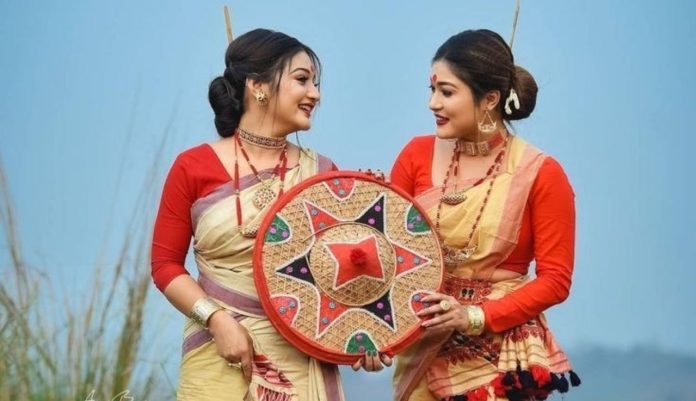Bohag Bihu, also called Rongali Bihu, or Xaat Bihu, is the most important and joyful festival of Assam. It marks the Assamese New Year and the start of the spring season. This festival is all about farming life, new beginnings, family time, and Assamese culture.
It is celebrated with great energy and happiness across Assam. People sing, dance, wear traditional clothes, and enjoy tasty food. Bohag Bihu brings people together and helps them start the new year with positivity and hope.
Table of Contents
Bohag Bihu 2025 Date
Bohag Bihu is usually held in the second week of April. It follows the solar calendar, unlike many other Indian festivals that go by the lunar calendar. This means Bohag Bihu usually starts on 14 April or 15 April.
In 2025, Bohag Bihu will begin on 14 April and continue till 20 April.
Apart from Bohag Bihu, the Assamese people also celebrate Magh Bihu in January and Kati Bihu in October. These three Bihus are connected to different parts of the farming calendar.
Different Days of Bohag Bihu
The seven days of Bohag Bihu are known as the “Xaat Bihu” in Assamese, which means “Seven Bihus.” Each day has a special name and unique customs. Here are the 7 Bihus of Bohag Bihu:
- Goru Bihu (Cow Bihu): Celebrated on the first day, this day is dedicated to cows and other farm animals. People wash and decorate them, and thank them for their help in farming.
- Manuh Bihu (Human Bihu): This is the first day of the Assamese New Year. People wear new clothes, take blessings from elders, and eat traditional sweets and dishes.
- Gosai Bihu: This day is meant for worshipping gods and goddesses. People clean the house and pray for a good year.
- Tator Bihu (Craftsmen’s Bihu): On this day, tools and instruments used in farming and daily life are cleaned, worshipped, and sometimes repaired.
- Nangolor Bihu: This day focuses on ploughs and other farming tools. Farmers prepare for the new sowing season.
- Senehi Bihu: A day of love and affection. Young boys and girls sing Bihu songs (Bihugeet), dance together, and exchange gamusas (traditional Assamese cloth) as tokens of love.
- Chera Bihu: The last day of Bohag Bihu. It is a day of rest, reflection, and visiting family and friends to end the celebrations with warmth.
These seven days together form a beautiful blend of culture, love, farming, and joy during Bohag Bihu.
The History of Bohag Bihu
The roots of Bohag Bihu go back to ancient times. It started as a spring festival celebrated by tribal communities and farmers of Assam. It was mainly about worshipping nature and thanking the Earth for its gifts.
Some historians believe that Bihu has very old origins, even before Aryan influence. The rituals and customs of Bihu were related to fertility, land, and crop blessings. The joy of the harvest and the hope for a good year ahead were always at the heart of the celebration.
When the Ahom kings ruled Assam for over 600 years, they also embraced Bihu and made it an important part of Assamese identity. Over time, even though Bihu absorbed customs from other communities, it always kept its true Assamese spirit alive.
The Importance of Bohag Bihu
Bohag Bihu is not just a celebration. It is a symbol of life, unity, and nature’s blessings. Since Assam is mainly a farming state, Bihu holds deep meaning for everyone.
The festival shows the Assamese people’s strong bond with the land and the environment. Lighting of Meji (bonfire), sharing homemade food, traditional songs, and dances are all ways of saying thank you to nature. It’s a time when everyone forgets differences and comes together in joy.
It also helps in keeping the culture strong, passing on traditions to the younger generation, and creating a feeling of equality. Rich or poor, young or old — during Bihu, everyone celebrates together.
How People Celebrate Bohag Bihu
- Bihu Dance and Songs: Young boys and girls wear traditional clothes and perform Bihu dance. They also sing Bihu geet (songs) which talk about love, nature, and happiness.
- Traditional Dresses: Girls wear mekhela chador, and boys wear dhoti kurta with a gamusa on the shoulder. These outfits are colourful and beautiful.
- Delicious Food: Special items like pitha (rice cake), laru (sweet balls made of coconut), and doi-sira (curd and flattened rice) are enjoyed by everyone. These are homemade and shared with guests and neighbours.
- Fairs and Cultural Events: Bihu melas are held in towns and villages. There are stalls, folk music, dance, crafts, and games. People from different communities come together to celebrate.
Conclusion
Bohag Bihu brings a fresh start with love, peace, and unity. It reminds us of our connection with nature and culture. In 2025, as Assam celebrates Bohag Bihu from 14 April, it will be a time of joy, hope, and togetherness for all. Whether you are in Assam or outside, Bihu gives everyone a reason to smile and celebrate life with family and friends.





